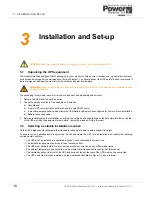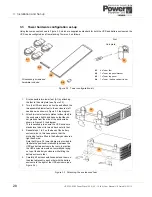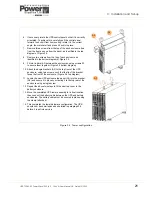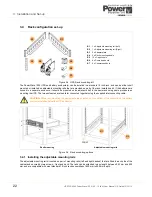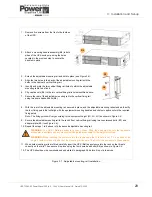
2: General Description
8
UPS725-02-02 PowerWave 1000 (4.5 - 10 kVA) User Manual UK Dated 13/03/15
Paragraph 2.3.1 described the internal operation of an individual UPS module. However, as an operational unit the UPS
can be described as being in one of four modes –
UPS
OFF
,
ON-LINE
,
ON-BATTERY
and
ON-BYPASS
– as illustrated in
Figure 2.2.
UPS systems are generally categorised as being either ‘On-line’ or ‘Off-line’ systems, and you can configure the
PowerWave 1000 to operate in either one. The difference between the two types of system are described below.
On-line UPS system operation
When used as an ‘on-line’ UPS the PowerWave 1000 is configured to normally operate in the
ON-LINE
mode, as shown
in Figure 2.2. In the event of a utility supply failure the UPS changes to its
ON-BATTERY
mode without affecting the UPS
output supply – i.e the changeover is totally transparent at the UPS output. The UPS then continues to provide its rated
output until the battery discharges to a low cut-off point, at which time the UPS will shut down in a controlled manner. An
alarm will warn that the battery is discharging to enable the operator to take any necessary intervention to protect the load
integrity.
During
ON-LINE
operation if the UPS experiences an inverter fault or overload condition the static switch transfers the
load to the static bypass line (
ON-BYPASS
mode) automatically and without interruption (transfer time = 0) provided the
inverter and bypass supplies are synchronised.
If the transfer is due to a UPS overload the static switch will transfer the load back to the inverter if the overload clears, and
the UPS will return to its normal
ON-LINE
mode of operation.
This system provides the highest degree of load protection, especially in the event of a utility mains disturbance or
complete failure; and we always recommended its use if the critical load (e.g. computer system) will not tolerate even very
brief supply interruption.
Off-line operation (single module installation only)
When the PowerWave 1000 is used as an ‘off-line’ UPS it is normally operated in its
ON
BYPASS
mode (Figure 2.2), with
the load supplied via the static bypass line. However the AC/DC converter and battery charger are still powered up and
maintain battery charging, and the inverter section is turned on and operating on standby.
In the event of a static bypass supply error, the inverter is immediately brought on line and the load is transferred from the
static bypass to the inverter by the static switch within 3 to 5 milliseconds – so the UPS is now operating in its
ON-LINE
mode. If the utility mains supply is unavailable when the transfer takes place, the UPS inverter will support the load
operating from its battery power (i.e.
ON-BATTERY
mode).
When the static bypass supply returns to normal, the load is re transferred back to the static bypass line and the inverter
returns to its standby operation.
Operating in this mode is slightly more energy efficient than operating in the on-line mode due to the reduced AC/DC
converter and inverter losses during normal system operation; and it is sometimes referred to as the “ECO” (economy)
mode. However this mode is recommended only if the connected load equipment can tolerate power interruptions of up to
3~5 ms during the transfer period.
Frequency changer operation (single module installation only)
In addition to the more normal on-line and off-line system operation, the PowerWave 1000 can also be used in a
‘frequency changer’ mode where the inverter output is produced at a different frequency to that of the utility supply – for
example 50 Hz utility mains input with 60 Hz UPS output, or vice versa.
When operating in this mode it is clearly not possible to switch the load between the inverter and bypass, so the bypass
side of the static switch is electronically disabled by the UPS control logic, which means that the static bypass line is not
available to assist clearing an overload. For this reason it is recommended that the UPS is operated to a maximum 75%
load capacity if the input voltage is 176~280 VAC and 50% if the input voltage range is set to 160-280 Vac.
WARNING:
The on-line mode should always be used for critical load protection.
























